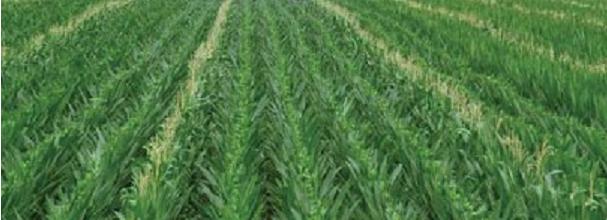Mankell Family History
Corn Detasseling in Minnesota, 1971
By Susan Muellner
By Susan Muellner

Tassels ready to be pulled.
I held my first job for about three weeks, removing tassels from Minnesota cornfields during the summer of 1971. Those few weeks provided me my first experience as an employee, complete with supervisor, performance reviews, a W-2 and an answer for the recurring question: What was your first job?
A day of corn detasseling began with my mom’s 5 a.m. wake up call. Mothers of several of us 16-year old “Norway Lake girls” carpooled 9 miles to New London to catch the 6 a.m. bus that took us and other area girls 42 miles south to Olivia where seed corn companies bred hybrid corn in huge cornfields. We met our crew chiefs at an Olivia truck stop and they directed our bus driver to that day’s assigned field.
Simply put, our job was to remove tassels from corn. In breeding hybrid corn, it is crucial that only the desired varieties pollinate. Detasselers removed tassels from specific rows of corn to ensure corn was pollinated only by the “bull row” variety, planted about every 5th row and not detasseled. Each detasseler was assigned a row to walk along and remove tassels. While corn was often only “knee high by the fourth” (of July) in my dad’s fields, corn stalks were over my head in seed companies’ lush, high maintenance fields. Squinting in the sun, I hunted for the tassel among folds of corn leaves looking like spikes at the top of each corn stalk, pulled the tassel up out of the leaves, and tossed it on the ground. Our crew chief provided on-the-spot performance reviews by checking our rows as we worked our way down the field. Detasseling season lasted three to four weeks.

Corn field after detasseling.
We must have been quite a sight. Even though detasseling took place in the middle of summer, a detasseler’s outfit included long sleeves and long pants because corn stalks sliced unprotected skin. We also wore:
- Layers of mosquito repellant and sun tan lotion (not called sun block back then),
- Hats or scarves,
- The absolutely oldest, rattiest shoes that were still comfortable enough for the miles we walked each day, and
- Sometimes a portable rain poncho to offer protection not only from rain showers but also from heavy morning dew.
By the end of a few weeks of corn detasseling, I was probably the tannest and blondest of any time in my teenage years. We ate lunch by the side of the bus, our only source of shade, and yes, there was no air conditioning on the school-style bus. And yes, there were no bathrooms, which is probably a key reason crews were separated between boys and girls. The lack of bathrooms made this job even more miserable; fortunately tall corn provided camouflage. When I complained about the hard work, my mothers’ response, “It’s good for you”, infuriated me. I received absolutely no recognition for the difficult task I had undertaken.
Several aspects of my detasseling experience illustrate I was a detasseler forty plus years ago and not now (in 2012). On our first day of work, most of us applied for a Social Security number since Social Security numbers were not required for young children until 15-20 years later. As a result, my number varies by only a few digits from some of my friends. We had no cell phones or ipods. I don’t think I would have thought to ask my parents if I could bring a camera in a lunch box or in a pocket while walking in corn. I have no pictures and “disposable” cameras did not exist. Bottled water products were not cheaply available back then (only fancy Perrier) and we instead brought small coolers with water. I would imagine that the company also provided water, but I’m not sure. I brought my lunch in an ice cream pail.
Prospective detasselers (needed in several states including Minnesota, Iowa, Illinois and Indiana) now find information on the internet--like the ASI, Inc. website I looked at. The wage for a crew traveling from Willmar to Olivia in 2012 is $8 per hour, compared to the $1 or so I earned. My annual Social Security earnings statement shows my corn-detasseling wages of $162 for 1971. I have seen online references to “porta-potties” for some crews but bathroom facilities are not on the list of “items provided” by ASI Inc. They provide gloves, goggles, water and water bottle clips. I don’t remember using gloves or goggles, but both make a lot of sense for protecting hands and eyes. Some companies use machines for the first round to get about 70% of the tassels, with detasselers getting the remaining 30%. It appears that most seed corn companies now outsource their detasseling function, but I believe I worked directly for the seed company. I would also imagine that crews in 2012 are more ethnically diverse.
Corn detasseling is a common bond for many Midwesterners. One of my Houston colleagues grew up in the southwestern corner of Minnesota and travelled northeast to the Olivia area to detassel corn too. Minnesota public radio featured detasseling on its “Summer Jobs” series in 2010. Even Cindy Crawford, the famous model , was “discovered” while detasseling by her home town of DeKalb, Illinois. I am surprised by the number of detasseling details I recall and I think this illustrates that my first job was, for me, a key teenage milestone.